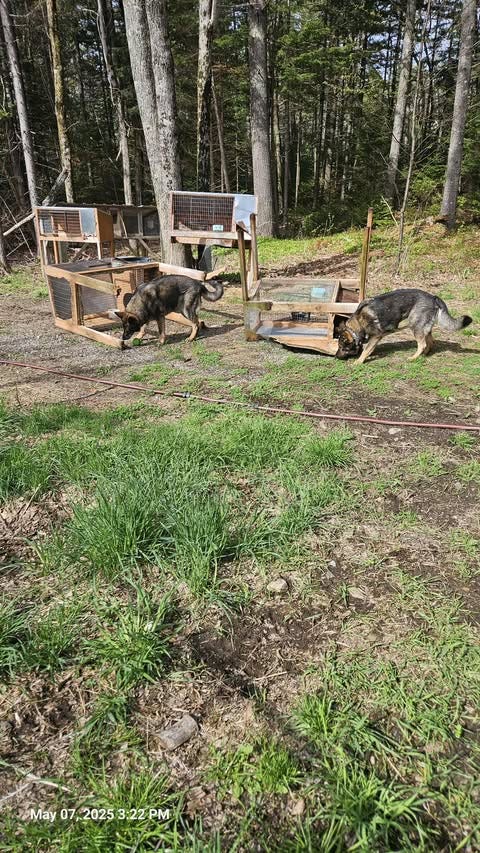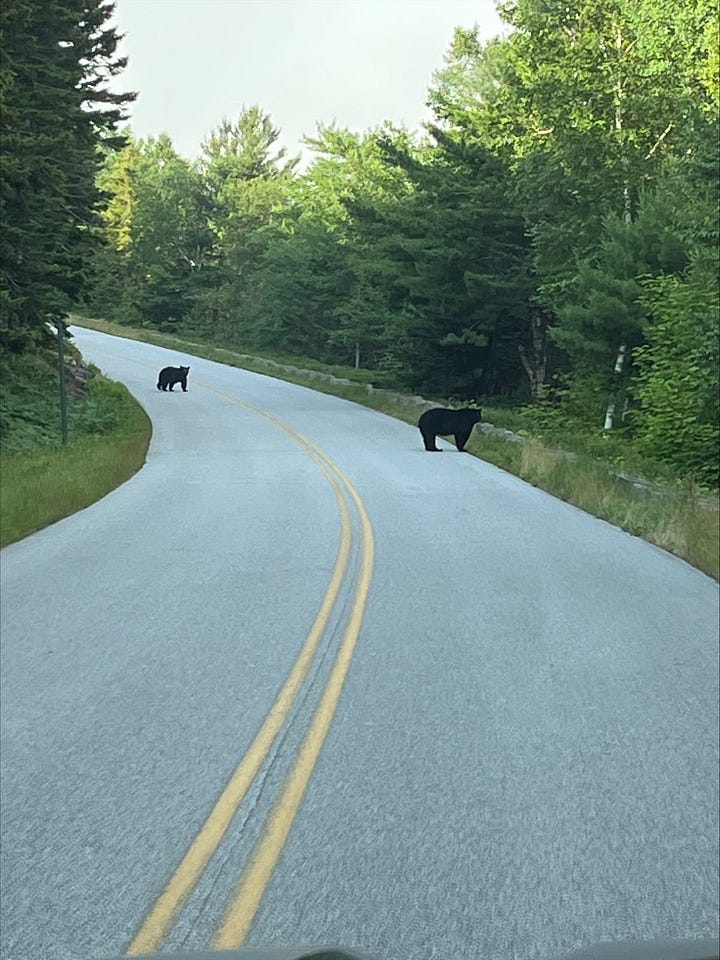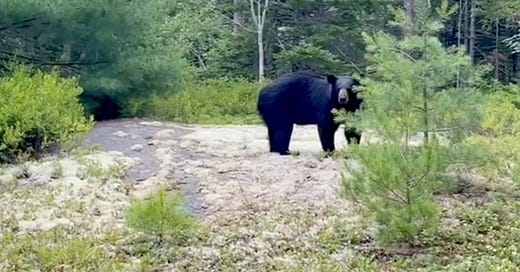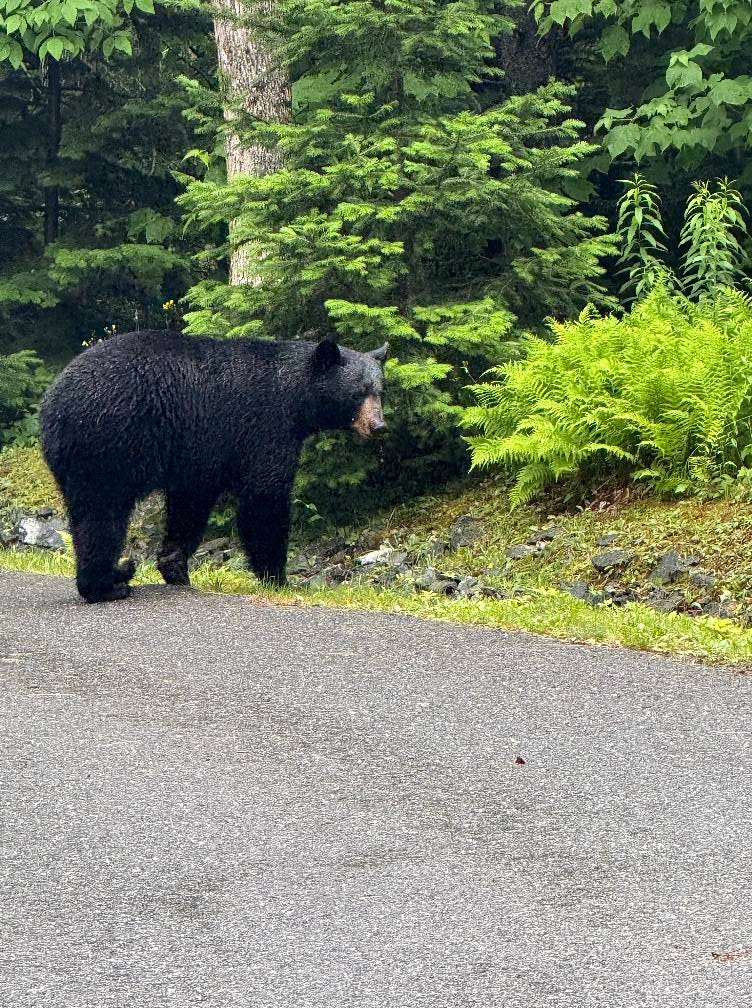The Bar Harbor Story is generously sponsored by Acadia Psychiatry.
MOUNT DESERT ISLAND—When you live in nature, you expect to see animals in nature. Deer, wild turkey, seals, turtles, osprey, ducks, the ever present squirrels, even coyotes live on Mount Desert Island.
But lately, people have been talking and posting and worrying a bit (and also getting excited) about bears as they wander about.
In the past month, a bear has been spotted at the head of the island; this past weekend it was sighted at Duck Brook Trail. In May, a bear reportedly went after local goats and destroyed fencing and rabbit hutches.
Bears are nothing new on Mount Desert Island, but the sightings this year seem to be coming quickly and all over Bar Harbor, Town Hill, Somesville, and Acadia National Park.
”Historically, Town Hill has had bear,” Jennifer Fisk, a resident who lost some animals to the bear this spring, said.
About 45 years ago, Draper Liscomb (who had the farm at the end of Fogg Road) told her about his Hereford cow ripping out fencing chasing a bear that was trying to get her heifer calf that he had named after Fisk.
The current bear on MDI paid Fisk’s home a visit on May 6, between 9:30 and 10 p.m. She was in bed and heard a squealing.
“I thought it was a dog on Black Watch Trail,” she said. “I considered opening a window and listening, but I was too comfy and cozy. The next morning I found the rabbit hutches destroyed.”
That wasn’t all.
“I had two pregnant does and a buck who I found deceased right next to a hutch and my young female GSD chowing down. Then I realized the goats weren't in their paddock or in the barn,” she said. “There were rumen contents in the paddock. Then I could see rumen contents and goat hair going out through the woods. My son followed the trail across Black Watch and to the stream without finding them. Those goats weren't small. I'm guessing they weighed 175-200 easily.”


“They (the goats) were 13 years old and not much of a challenge for a determined bear. It came back the night of the 7th and emptied my hummingbird feeders which are 10ish feet from the house. I haven't seen any indication that it has been back since May 6 and 7,” Fisk said. “There are two galvanized trash cans with grain in the barn that it could have gotten into. I bought a pregnant doe rabbit so have eight grow out kits in a hutch that would be an easy mark for a bear but so far so good. I raised 25 meat chickens in the goat paddock without incident.”
According to Acadia National Park Management Assistant John Kelly, most of the sightings in the park have been in the Jordan Pond area. Since mid-June, people on social media have reported seeing a bear on the Kane Path, Dorr South Ridge Trail, Bald Peak Trail, and Cadillac Mountain.
On the morning of July 13, resident Carla Tanguay was on the Duck Brook Road when she saw a bear meandering on the granite. Video of that encounter is below, courtesy of Tanguay.
Matthew Hochman saw a bear at the head of the island. Peter Miano saw and photographed a bear off Bayview Drive.
The black bear is the smallest of the bear species in North America.
“Black bears have compact bodies, stocky limbs, a massive skull, and short, round ears. Males grow 50% larger than females, reaching 6 feet from nose to tail, and stand 40 inches at the shoulder; females will reach 5 feet in length, and rarely stand more than 30 inches at the shoulder. Males normally weigh 250-350 pounds, with large specimens weighing over 500 pounds; adult females weigh 150-200 pounds but can exceed 300 pounds or more in unusual circumstances,” according to a 1999 assessment by Craig R. McLaughlin, a wildlife biologist with the Maine Department of Inland Fisheries and Wildlife.
Bears like tree cover. It helps regulate their body temperature.
“Their movements and activities are largely determined by the distribution and developmental stages of vegetation that they use as food. In the spring, bears will visit the edges of wetlands, roadsides, recently clear-cut areas, and agricultural fields to feed on newly emerging grasses and herbaceous vegetation. They also frequent regenerating stands of aspen and mature hardwoods to eat buds and new leaves. If the previous fall’s beechnut or acorn crops were abundant, bears will move to mature beech or oak stands to eat nuts that over wintered on the forest floor. During the summer months, bears continue to use roadside openings and regenerating forests, including recently clearcut and partially cut stands of hardwood and softwood. These areas provide an abundance of berries and insects, and usually contain dense understories for escape cover. By fall, bears move to mature hardwood-dominated stands to take advantage of beechnut and acorn crops, and to a lesser extent, beaked hazelnuts and persistent berries of mountain ash and cherries. If nut crops are scarce, bears may forage on cranberries and winterberries along the fringes of wetlands. They will also visit the fringes of agricultural areas to feed on apples, corn and oat crops, but rarely venture far into open areas devoid of protective cover. Throughout the year, bears are never far from dense cover,” McLaughlin wrote.
Stephen Dunham, a regional wildlife biologist with the Maine Department of Inland Fisheries & Wildlife said, “I am aware that there have been sightings of a bear on MDI this year, which is not surprising given that bears are abundant in our state and that bears can and will swim to find food. Bears have been seen on the island in previous years as well.”
In the past, bears have been seen throughout Town Hill and on Ledgelawn Extension in Bar Harbor near Great Meadow as well as on various mountains in the park, Somesville, and the Indian Point area. Usually, the bears are moseying on by or looking for food in blueberry bushes and deadfall.
“This is a good chance to remind the folks that live on MDI that they should be following the recommendations we make every spring and to avoid putting out bird feeders from April 1 to November 1 and to make sure their trash, grills, and other potential food sources are secure,” Dunham said. “A reminder I like to give folks is that if you place any type of food out (bird seed, scratch feed for chickens, etc.), you don’t get to choose what is attracted to that food. Many people don’t realize how many mice, rats, deer, turkeys, and other animals are feeding on the food they are putting out for the birds.”
Bears, Dunham said, “are a part of our forested ecosystem and their entire purpose once they emerge from hibernation is to gather calories as efficiently as possible so they can be ready for the next winter.”
This could explain the interaction at Fisk’s home early in May.
”Anthropogenic food sources like bird seed, compost, garbage, etc. tend to be much more abundant and calorie rich than natural food sources, especially in the early spring before grasses (Yes, bears eat grass!) and berries come on,” Dunham said. “Bears feed primarily on vegetation, insects, and insect larvae. They will eat meat but are not efficient predators, so they tend to eat less meat than most people expect. Bears are all about efficiency and grass is easier to eat in bulk than chasing down something large and fast.”

Dunham said the department doesn’t know the bear’s sex or if there’s more than one making its home on the island.
However, on the Fourth of July, Oli’s Trolley posted images on its Facebook page of two bears on Cadillac Mountain Summit Road.
According to McLaughlin, Maine black bears have different ranges for the sexes. Females range 6-9 mi2 and males can range “up to 100 mi2 or more.”
“I would suspect that there could be more than one given the size of MDI, but that is not based off of any detailed sightings/reports,” Durham said. “Our office in Jonesboro has only received a few reports of actual sightings and almost all involved bird feeders and/or trash. These people were told to remove/secure the items that were attracting the bear. There was one call that involved goats, but it was from early May, was received several days after the actual event, and there was no apparent pattern of behavior or subsequent reports to suggest that it was anything other than an isolated incident.”
Dunham recommends electric fencing for livestock.
“We do not currently have a plan to move any bears at this time, and to be honest, moving bears is not a good long-term solution as they often return even after being moved many miles. Female bears are especially notorious for returning to their preferred area. Additionally, if bears are moved, there is a high likelihood that the folks in the area will return to their bad habits and could easily attract a new bear to the area. If a pattern of livestock damage develops, the bear will likely need to be euthanized, but so far, we are only aware of the one incident. Acadia National Park is working with their campgrounds and facilities to secure dumpsters and attractants to prevent any issues,” Dunham said.
A bear has also been sighted this past month on Oak Ridge and Oak Hill in Somesville, Seal Harbor, Round Pond, Prospect Ave in Bar Harbor, Whitney Farm, and Otter Creek.


”The biggest thing the residents of MDI should be aware of is that bears can exist on the island and they should be following the recommendations provided by Bear Wise or our website,” Dunham said. “Most bears do not want to interact with people and will run off, but if a bear becomes habituated to being near people because of repeatedly finding food near humans they may not run away or act like a wild bear. Problem bears are not born that way, they are trained by people, even if that training is inadvertent or unintentional. This is why we ask people to take preventative steps before a bear shows up. Bears are powerful, wild animals and should be given space and respect. The best way to do that is to avoid attracting them into your space.”
“We would also encourage folks to report incidents of bears attacking or killing livestock to my office (207-255-2080 and press 1 for wildlife) or to the Warden Service by calling the state police dispatch (207-973-3700),” Dunham said.
FROM THE MAINE IFW
To prevent conflicts with black bears each spring (April 1-October 1):
Bring in your bird feeders, rake up and dispose of any seed left on the ground, and store unused seed inside. If you want to continue to feed birds in the spring and summer consider using an electrified mat (MS Word).
Bring trash to the curb on the morning of trash pickup or use a certified bear resistant container.
Keep dumpster lids closed and do not allow dumpster to overflow. In areas experiencing bear problems consider storing dumpsters in a secure building or behind electric fencing (MS Word).
Clean your grills and empty the grease cup after each use. Do not discard grease on the ground. Burn-off any food residue, clean blood and grease dripping, and discard food wrappers.
LINKS TO LEARN MORE
Follow us on Facebook. And as a reminder, you can easily view all our past stories and press releases here.
If you’d like to donate to help support us, you can, but no pressure! Just click here (about how you can give) or here (a direct link), which is the same as the button below.
If you’d like to sponsor the Bar Harbor Story, you can! Learn more here.
THANK YOU FOR SUPPORTING OUR COMMITMENT TO YOUR COMMUNITY












Wonderful coverage and photographs. Thank you!
Lack of Canadians in Bar Harbor can be attributed to politics but the 30% exchange rate is a significant factor.